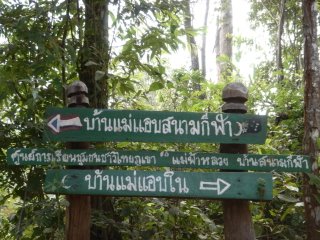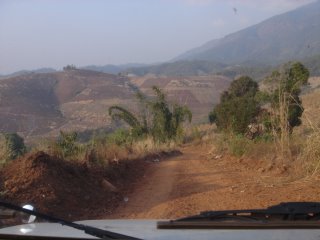
1000 Kilometers In Thailand's Wild Frontier: Part 2
If we were looking for adventure we found it
After exploring the diverse but relatively sterile and benign Doi Inthanon National Park we were ready to visit more remote sites in the northwest. Immediately after crossing the park boundary we took a steep and roughly paved road the switchbacked to a small but worthwhile series of waterfalls. It was a big change to be all alone sitting alongside a Thai river. The park, who's watersheds fed the stream we sat by, was full of people (though predominantly Thai). We were happy to have a relaxed short hike and lonely clear pools all to ourselves. Instead of retracing the steep paved road from the falls we turn out of the parking area following signs in Thai script. Immediately the road turned to dirt and we began to see signs (in Thai, though we now recognized the white on green lettering) hinting of tribal villages ahead. I shifted the Suzuki into 4WD and wecrawled slowly over muddy boulders and navigated off-angle half-gravel half-sand swichbacks to an unknown goal.
 At a dusty intersection at a mountain pass we pulled into a village with a small handful of what I think were Hmong villagers. The Hmong are mountain people that have immigrated from Burma, they are firmly holding onto their culture as the 21st century decends upon them. They are animists (worship and give thanks to many 'natural' gods), dress in traditional colorful costume, and are known for thier skill in farming both opium and hemp. Just ten years ago visting this region would have been much more precarious, for these Burmese border villages were second only to Afganistan in opium (the raw ingredients for herion) production. Agressive efforts by the Thai governments, and especiallly the Thai royal family, have helped these tribes to trade poppy farms for cold vegetable crops such and cabbage, onions, and cut flowers. In turn the stilted homes of the Hmong are now adorned with satelites and solar panels - the streets in the villages are generally paved. Officially, poppy fields are gone and opium production is now "negligiable." It has been hard for us to determine whether the new crops equal the income of an expensive drug crop and how the villages are faring after a disjunct drug war/rehabiltation program that has spanned many erratic Thai central governments. English information on these subjects is, naturally, hard to come by. When we pulled into Mae Noi we could do little more than communicate the direction of our next mapped destination. Some villagers gave slight smiles, though others offered more baffled looks, as they tended their pigs and many small children. The women were generally more friendly and returned our waves - the children most always smiled and waved and sometimes ran alongside the jeep.
At a dusty intersection at a mountain pass we pulled into a village with a small handful of what I think were Hmong villagers. The Hmong are mountain people that have immigrated from Burma, they are firmly holding onto their culture as the 21st century decends upon them. They are animists (worship and give thanks to many 'natural' gods), dress in traditional colorful costume, and are known for thier skill in farming both opium and hemp. Just ten years ago visting this region would have been much more precarious, for these Burmese border villages were second only to Afganistan in opium (the raw ingredients for herion) production. Agressive efforts by the Thai governments, and especiallly the Thai royal family, have helped these tribes to trade poppy farms for cold vegetable crops such and cabbage, onions, and cut flowers. In turn the stilted homes of the Hmong are now adorned with satelites and solar panels - the streets in the villages are generally paved. Officially, poppy fields are gone and opium production is now "negligiable." It has been hard for us to determine whether the new crops equal the income of an expensive drug crop and how the villages are faring after a disjunct drug war/rehabiltation program that has spanned many erratic Thai central governments. English information on these subjects is, naturally, hard to come by. When we pulled into Mae Noi we could do little more than communicate the direction of our next mapped destination. Some villagers gave slight smiles, though others offered more baffled looks, as they tended their pigs and many small children. The women were generally more friendly and returned our waves - the children most always smiled and waved and sometimes ran alongside the jeep. The road from the village was tracked with hooves, feet, and motorbikes. Our jeep left the only 4-wheeled tracks in the thick dust. We decended grades of atleast 20-25% through cabbage and other small agriculture plots. It only thing I can compare it to was maybe driving in snow, where too much braking only rendered your front tires useles for steering so it became an uncomfortable balance of sliding without direction and gaining speed while steering. There was no way we would be able to climb this loose road to return the way we came. Decent was the only option. More small stilted homes appeared, rice paddys hinted that we had dropped over 1500 meters in elevation. Signs in Thai indicated more villages may be ahead, our map was vague but encouraging. We passed a single wooden and bamboo house with a rusted Toyota truck (a good sign) and then crossed a small wooden bridge to a graded road. We weaved through dense mixed-race villages to the town of Mae Chaem. We filled our empty stomachs and gas tank, used our map to locate a clean, friendly and cheap hotel ($8), and settled in along a small river at the edge of town.
The road from the village was tracked with hooves, feet, and motorbikes. Our jeep left the only 4-wheeled tracks in the thick dust. We decended grades of atleast 20-25% through cabbage and other small agriculture plots. It only thing I can compare it to was maybe driving in snow, where too much braking only rendered your front tires useles for steering so it became an uncomfortable balance of sliding without direction and gaining speed while steering. There was no way we would be able to climb this loose road to return the way we came. Decent was the only option. More small stilted homes appeared, rice paddys hinted that we had dropped over 1500 meters in elevation. Signs in Thai indicated more villages may be ahead, our map was vague but encouraging. We passed a single wooden and bamboo house with a rusted Toyota truck (a good sign) and then crossed a small wooden bridge to a graded road. We weaved through dense mixed-race villages to the town of Mae Chaem. We filled our empty stomachs and gas tank, used our map to locate a clean, friendly and cheap hotel ($8), and settled in along a small river at the edge of town.
No comments:
Post a Comment